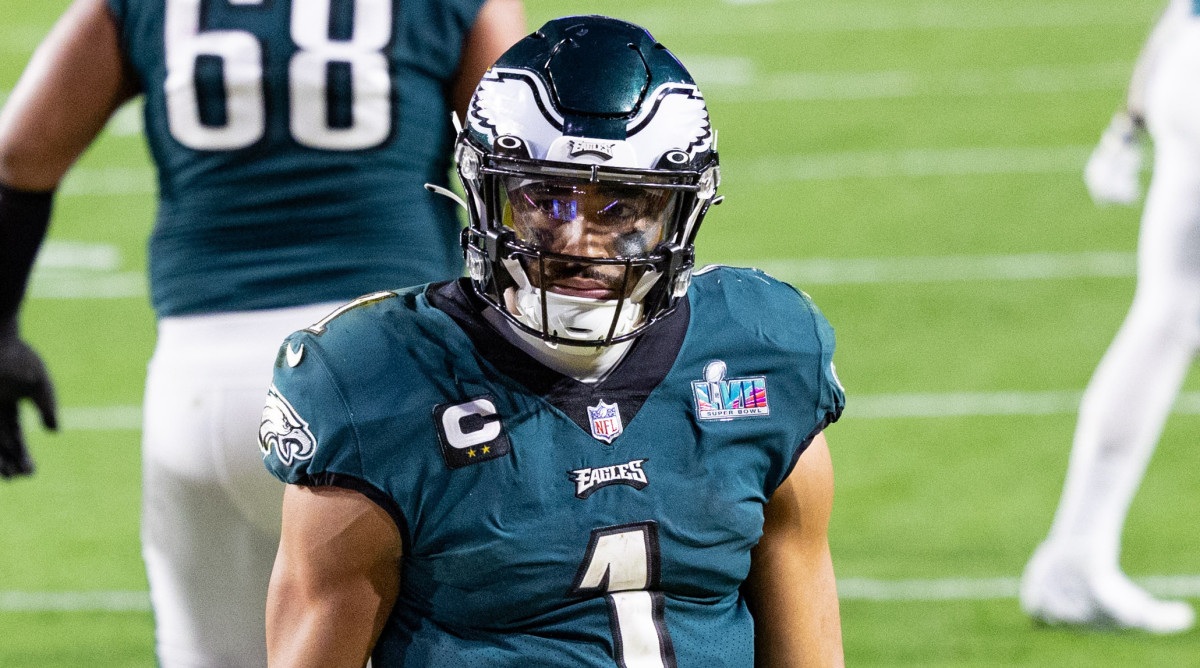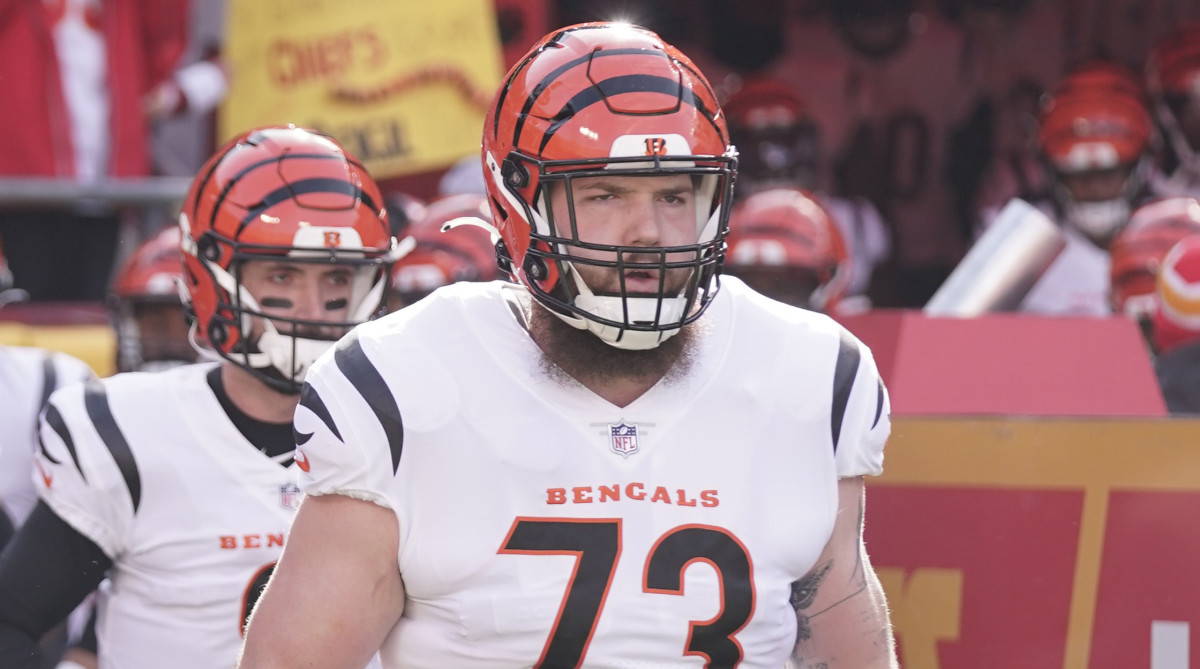Jalen Hurts’s Extension Presents a Lot of Difficult Challenges for Eagles

I’m on spring break with the family, sunburned and overrun by elementary schoolers (and preschools). But there's no time to take a break from the NFL, so let's go …
• The first thing I thought looking at the numbers of the Jalen Hurts deal—it was smart of the Eagles to get it done now, expensive as it might’ve been, and smart of Hurts to take the life-changing windfall that Philadelphia offered him.
Will Joe Burrow and Justin Herbert outpace this deal within a few months? Probably.
Are the Eagles assuming risk, after extending Carson Wentz after his third year? Sure.
But in the end, this is a bet on Hurts the person for Philly, and this is Hurts taking advantage of a team motivated to get a deal done before Burrow (or Lamar Jackson, if that one gets done) gets one that could move the market in Cincinnati, and it’s understandable why that bird in the hand was better than two in the bush for both parties.
The hard part, for everyone, is what comes next. With Hurts on a rookie contract, Philly could afford to make up for draft misses at receiver by trading for A.J. Brown and signing him to a massive new contract. They could pay to keep, well, nearly every vet they wanted to. And now, the dynamic changes. How do they replace Lane Johnson and Jason Kelce over the next couple of years (the latter’s long-term heir, Cam Jurgens, may already be in place)? Do they pay DeVonta Smith? And how do they get younger rushers and corners on defense?
Those are just some of the questions they’ll have to answer over the term of Hurts’s deal, and they’ll have to find those answers with less financial flexibility than they’ve had, which is the challenge the Chiefs and Bills have had to face the past couple of years. It’ll put pressure on Hurts to raise the level of the people around him, and on GM Howie Roseman to find more affordable talent in the draft.
But if how Hurts played in the Super Bowl (27-of-38, 304 yards, TD; 15 carries, 70 yards, three TDs) is an indication of where he’s headed as a player, then these are the sorts of champagne problems that a lot of teams would love to have.

• I’ve heard a lot of people compare Hurts to Lamar Jackson, but, to me, there are a few key differences between the two. First, there’s the fact that the Eagles did the Hurts deal after his third year, and Jackson has now played five. Second, Hurts has made $4.6 million through three years, and was set to make $1.43 million this year, while Jackson has made $32.50 million through five years and is on a $32.42 million tag for this year.
For obvious reasons, it's a lot easier to play hardball when you know your career earnings will be nearly $65 million after this week, than it would be with that same number set to barely clear $6 million by the end of 2023.
Now, that doesn’t mean Jackson should or should not have turned down $200 million in guarantees from the Ravens. It’s just a lot easier for him to than it would be for Hurts.
• So what does this mean for Burrow and Herbert? Right now, not a lot.
The Chargers and Herbert’s reps agreed to wait until after the draft to start the heavy lifting in negotiating a long-term contract, with hopes of getting a deal done in the summer. And my guess is the number Herbert will get was always going to be north of the $51 million APY that Hurts is taking home—though all that stuff is negotiable based on how much of a deal is guaranteed, and the cash flow and structure of the contract.
My guess would be that Burrow’s deal happens after Herbert’s, given that he’s the most accomplished of this group of young quarterbacks from the 2020 draft, and the one with the best shot to hit the $55 million benchmark.
Also interesting here is the Chargers and Bengals aren’t flush with cash the same way some other franchises are, which could affect the way guarantees are set up in these sorts of deals due to the complications caused by the league’s archaic (and really, really ridiculous) funding rule involving escrow accounts.
• Kudos to Andy Reid for giving Patrick Mahomes his blessing to hold a players-only camp in Dallas over the first two weeks of the Chiefs‘ offseason program for the second consecutive year. Those two weeks account for Phase I of the offseason program through which players can meet only with coaches, and lift and condition, making a player-led camp off-campus a more productive use of that time, anyway.
I remember talking to Reid about the idea at camp last year. He glowed about the benefits of it—and that was before he won a second Super Bowl with Mahomes.
“Tremendous. Tremendous,” said Reid. “They all rented homes down there, and [Mahomes] conducted the throwing practice. So it was all the receivers, tight ends, and they were able to bond so when we got them back for Phase II, they’d gotten through all that stuff. Now it’s just a matter of getting on the field and let’s go, and I just think that’s his leadership. He’s a natural leader.”
The team’s top receivers and All-Pro tight end Travis Kelce are all expected to be there, some for part of Camp Mahomes, others for all of it. Reserve tight ends Blake Bell and Noah Gray and first-year Chiefs wideout Richie James, coming over from the Giants, were among the first to report to Texas, and were on the field with Mahomes on Monday.
All those guys, by the way, can (and will) Zoom into meetings with coaches over the next two weeks, too.
• While we’re there, Justin Fields was present for the first day of the Bears’ offseason program, and he’s back much healthier than he was at the end of the season. Fields spent time with his teammates during the three-month break, but rested and rehabbed physically after the toll last year took on his body—160 carries will leave a mark.
There’s plenty of optimism that, with a year of reworking his throwing motion to make it a little less robotic, Fields will come back ready to make a leap as a passer. That, combined with the addition of DJ Moore and some help in the draft, will lessen the need to run him.

• Zac Taylor was guarded in discussing Williams’s future with the Bengals, with Williams having requested a trade in March, and that, obviously, is understandable.
“I’ll keep all that stuff private, about conversations with my players,” Taylor said, during his Monday press conference.
The problem here is that Williams’s motivation to ask for the trade isn’t about money, so much as it is about the position he’ll play. Orlando Brown Jr. signed with the Bengals because they planned to play him at left tackle (he wants no part of going back to the right side). Cincinnati’s plan was to flip Williams to the right side, at least while right tackle La’el Collins works back from a torn ACL. Williams last played right tackle as a true freshman at Alabama in 2016—he’s been a starting left tackle, in college and the pros, ever since.
The resulting problem for Williams is twofold. One, he’s more valuable in pursuit of a top-shelf contract as a left tackle, and presumably, after Cincinnati signed Brown, that contract will have to come from another team. Two, with Collins still around, there is potential he’d be asked to move inside to guard eventually, a position some saw him at before the 2019 draft but one he’s never played.
So the question then becomes whether the Bengals can get him to take one for the team here, even though he’ll probably be on another team in 2024. And thus far, the answer to that question is he’d rather just get to that new team this year.
• Zach Wilson showing up for the Jets’ offseason program is relevant, and not because it means anything related to Aaron Rodgers.
Ideally, and the Jets know pulling this off will be tricky, Wilson would back up Rodgers for a year or two, develop in the background and be in position to take over for him in 2024 or ’25, depending on how much longer the current Packer/likely-soon-to-be Jet wants to play. The Jets, for their part, think he needs it. And it sounds like Wilson is pretty open to the idea of learning from Rodgers (with whom he has a relationship) for the time being.
• Bryce Young calling off any remaining 30 visits probably means exactly what you think it does.
But, generally, I’d say there is merit to guys taking them, even if they know the teams inviting them might not be in position to draft them. That’s because it’s a chance to make an impression on coaches, GMs, front-office people and owners. Teams file away their predraft evaluations and they certainly can impact how they approach guys four or five years later when they become free agents.
So, yeah, for the players, there can be more value to these things than just the steak dinner.
• Comment that caught my eye Monday? It came from Rams QB Matthew Stafford, who confirmed he’d be a full participant in the team’s offseason program.
“Yeah, I’ll be out there. I’ve been throwing with the guys a decent amount leading up to this. So, I feel good,” Stafford said. “Obviously, going to do everything I can to try to be as healthy as I can at all times. [I’m] not probably a human JUGS machine like I used to be. But I can still get it out there and throw it around a bunch.”
To me, that’s an acknowledgment of the seriousness of the elbow issue he endured last year, and means there’ll be a level of management he’ll need on his throwing arm going forward. Of course, say, 90% of Stafford-level velocity would be better than most quarterbacks in the league at 100%. But it’d still be 90%. And for that reason, it’ll be worth keeping an eye on.
• Didn’t think we’d get Nick Caserio comparing himself to Leonardo DiCaprio this week, but it happened in Houston on Monday. And the Texans GM saying he’s staying, amidst a lot of speculation—and rumors were flying on this at the owners meetings last month—is significant. Especially since he made it a point to say it on his own, before he was asked a single question about it.
That said, there are fair questions to be asked about the way things will be structured going forward between Caserio and new coach DeMeco Ryans, and how that’s affected by what is in each guy’s contract since both arrived in Houston with leverage to gain power.
